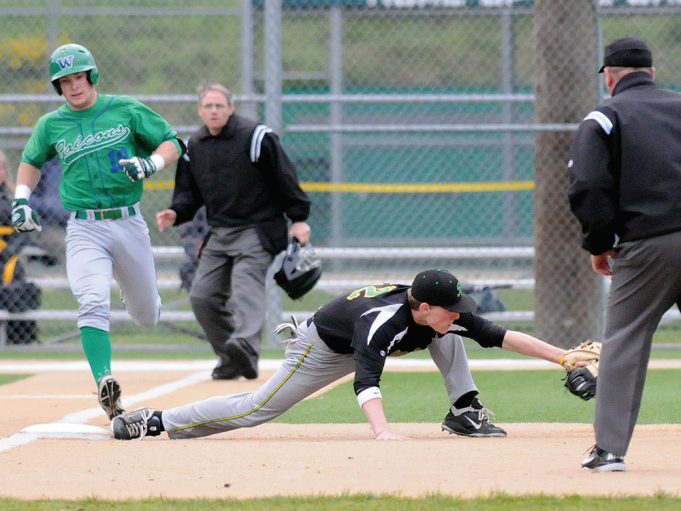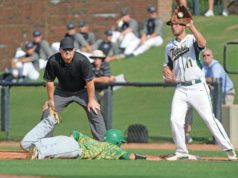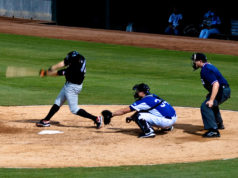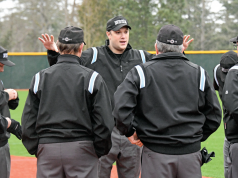We are all taught early in our umpire training that some plays will occur that need to be sold harder than others. The type of play, along with the game situation that it falls under, will normally dictate when we need to be more demonstrative in letting players, fans and coaches know that we have something that they may not have expected. Those calls require a little more than just the louder voice and stronger signal required on a “whacker” or “one sounder” on the bases. I have a good friend in umpiring that calls those the “jump out of your shoes” calls.
One such situation comes when a batter is hit by a pitch, but you are not going to award him first base because he made no attempt to avoid being hit. That call is invariably going to lead to protest, so being on top of it right away in a manner that lets everyone know what you have is imperative.
In many cases the batter will have already started toward first, so you will have to come out from behind the plate and motion that he needs to come back to the batter’s box. A very strong signal such as pointing at the batter and then directly to his spot in the batter’s box is in order.
Calling batter’s interference when there was obvious contact between the hitter and catcher on the catcher’s attempt to throw out a runner needs to be sold. However, what about a situation in which there was no contact, or the catcher does not even make a throw? You may still have batter interference, and that is going to require coming out from behind the plate, pointing emphatically at the hitter and making a strong out signal.
Another situation needing a hard sell is when the interference is preceded by strike three. That means you are going to call the runner out on the batter’s interference in NCAA and pro and have the option of calling the runner out in NFHS.
Coming out from behind the plate and pointing at the batter while saying, “That’s interference!” will need to be followed by you moving toward the base where the runner ended up, pointing at him with an out signal and saying, “That runner is out!”
Another one of these unexpected calls for plate umpires that really needs a hard sell is when a batter who is attempting to bunt makes contact with the pitch while his foot is outside of the batter’s box.
While trying to bunt for a base hit, many speedy players will get a running start on the bunt attempt. If they have a foot completely outside the batter’s box at the time of contact, you will have to nullify a possible successful bunt attempt by calling the batter out. Even if the batter fouls the pitch off, you are still going to have an out with any contact with the bat in that situation. That will be a very unexpected call that again will require pointing to the spot where the batter’s foot was outside the box at the time of contact and following that with an emphatic out call.
One unexpected situation that arises occasionally in baseball is the time play. When the third out is made on a non-force-out situation on the bases at the same time that a runner from third is about to step on the plate, the plate umpire must determine if the runner scored before or after the third out was recorded on the bases. If the run scores, the umpire should wave at the press box and then point forcefully down to the plate indicating that the run scores. Conversely, if the out was made just prior to the run scoring, the umpire needs to be just as vigorous in selling that fact. It is vitally important for the plate umpire to again wave at the press box and then make a similar signal to what a basketball official would make in not awarding a last-second shot (open palm hands crossing above your head a couple of times). Some umpires will make a signal similar to a football official declaring a pass incomplete, but that looks too much like a safe signal, leading to potential confusion.
Any time obstruction is called, an ardently demonstrated call is in order. However, when that obstruction takes place on a runner on whom a play is not being made, you may have to have a little more insistence in your tone and demeanor after playing action is over. Since that does not result in an immediate dead ball, your call will come after all playing action has ceased.
Because you may be the only one on the field who saw the play, you will have to sell your possible award of additional bases to an unsuspecting group of players, coaches and fans. You should point at the incident and call out, “That’s obstruction,” when it occurs. However, after the play is over, if an award of additional bases is warranted, you’ll need to call time, point at the runner and then signal the base that he will be awarded, while repeating that you had obstruction. A strong voice and vigorous insistent signals will help defuse what could potentially lead to a volatile situation.
A couple of plays at second base come to mind when thinking about situations that require a hard sell. One involves invoking the force play slide rule.
Pointing at the runner while barking out, “That’s interference,” should be followed by turning and pointing to first and indicating that the batter-runner is also out.
The other situation that can happen in many different locations and situations on the field is the catch and drop of the ball on a voluntary transfer and release. Probably the most common occurrence is the front end of the double play in which the fielder covering second base catches the throw from his teammate in time to get the runner, but loses control of the ball in the transfer from the glove to his throwing hand.
As you sell the catch and out at second with a strong out signal and then mimicking the transfer from the glove to the throwing hand, it is important to make sure that your two hands are moving in a vertical direction, so as not to be confused with a safe signal.
One final note to consider is that “coming out of your shoes” to sell unexpected calls should be limited to situations that require such histrionics.
Any umpire who oversells calls that don’t require such emphasis will quickly lose credibility with his partners and the rest of the participants in the game.
What's Your Call? Leave a Comment:
Note: This article is archival in nature. Rules, interpretations, mechanics, philosophies and other information may or may not be correct for the current year.
This article is the copyright of ©Referee Enterprises, Inc., and may not be republished in whole or in part online, in print or in any capacity without expressed written permission from Referee. The article is made available for educational use by individuals.



















